Coordinated Operation of Electricity and Natural Gas Networks with Consideration of Congestion and Demand Response
Abstract
1. Introduction
- Proposed a novel CO framework and this changes the traditional decision sequence. With this framework, it is possible to avoid frequent information interaction and without a third coordinator.
- A model is constructed to generate NGFUs’ gas consumption constraints. A CR indicator and an update method are introduced, to generate reasonable gas consumption constraints information deliver from gas network operator (GNO) to electricity network operator (ENO).
- Impact of considering classic demand response program [33] and congestion is discussed in a decentralized and coordinated operation. For GNO optimization sub-problem, an improve SCP method based SOC with reasonable initial expansion value is used to determine the steady-state gas flow in a natural gas network.
- Simulations under different scenarios, considering the NG and electricity networks operation, based on a benchmark 6-bus electricity system and 6-node natural gas system were used to verify the proposed framework, considering solution convergence and benefits obtained.
- The impact of the coordinated operation is studied with congestions and demand response. The present method can give a better convergence when compared to a very popular method such as ADMM.
2. Framework for Coordinated Operation
2.1. Coordination of Interdependent Electricity and Natural Gas Systems (IENS): An Overview
- From the perspective of the macro scope of the energy system model, the models can be classified from four aspects: comprehensive evaluation, energy economy, power system planning, and energy system planning [34]. They have different methods, different ranges of use and different fields of application. Energy modeling tools such as LEAP, EnergyPlan, MASSAGE, MARKAL/TIMES have been designated for sustainable energy planning analysis [35]. The main methods of energy system modeling are top-down and bottom-up. The combination of these models leads to a hybrid energy model.
- In IENS, due to the uncertainty of natural gas supply, the balance of supply and demand in power system may be affected for security and economic purposes. Power system researchers have incorporated natural gas transmission constraints into the unit commitment problem of security constraints [12,23,24]. The uncertainty of natural gas supply and the variability of natural gas price are also considered in reference [36] to study the impact of natural gas supply shortage on the optimal dispatch of power system.
- The collaborative optimization of IENS considers the power grid and natural gas network as a whole to minimize the total cost associated with the two energy systems. It can achieve the best solution for the whole IENS [40,41,42]. In addition, considering that power grid and natural gas network may belong to different system operators and information exchange may be restricted by policies, researchers explore decentralized algorithms to obtain high-quality coordination solutions of IENS, while maintaining decision independence and information privacy of the two systems [43,44,45]
- IENS should be considered from operational and long-term planning aspects [46]. Co-planning of power and natural gas networks can be proposed at system level [47] and local level [48]. The integration of natural gas and power sectors usually needs to study the interaction between them and Resource Co-optimization from the perspective of central planners [49]. The mathematical model used in the joint planning of electric power and natural gas shows that some relationships are nonlinear and nonconvex [50]. The most common problem in this paper is MINLP model [51]. In order to solve the complexity of the model, various techniques of linear and convex reconstruction/relaxation [52] and decomposition method [53] are proposed.
2.2. Coordinated Operation Method Based on ADMM Algorithm
- Parameter initialization: Initialize the coupling variable values of the power grid sub-problem and the natural gas network sub-problem respectively. Initialize the coupling variable value of the third-party dispatching department, set the ADMM algorithm step size ρ1and ρ2. Initialize the Lagrange multiplier of the grid sub-problem and the gas grid sub-problem respectively.
- Simultaneously solve the electricity network subproblem and the gas network subproblem.
- Update ADMM multiplier and third-party coupling variable.
- Convergence criterion: The original residual is the coupling unbalance, and the dual residual is the difference before and after the iteration of the coupling variable.
2.3. Traditional Decentralized Operation
- Step 1: ENO carries out the optimal local scheduling of electricity network which described as ENO sub-problem, and the corresponding consumption of natural gas information will deliver to the GNO.
- Step 2: GNO carries out the optimal scheduling of natural gas network and is described as GNO sub-problem. If GNO cannot supply enough expected gas volume in Step 1 as the premise of resident gas demand has a higher priority, ENO needs to re-dispatch in the electricity network.
2.4. A New Framework for Coordinated Operation
- Step 1: Receive NGFUs’ CR from the previous period, GNO calculates the maximum profit with an uncertain gas load of NGFUs, named GNO sub-optimization-A problem. GNO as advance decision-maker provides NGFUs gas consumption constraints to ENO. To generate reasonable gas consumption constraints information that deliver from GNO to ENO. This means that the natural gas network supplies the maximum capacity to NGFUs.
- Step 2: ENO set the maximum gas supply of NGFUs as constraints in optimization sub-problem to determine the hourly dispatch, including the dispatching generation and actual gas consumption of NGFUs.
- Step 3: After receiving the actual gas load of NGFUs in natural gas network, GNO optimizes the gas network scheduling to achieve the minimal operation cost and updates the CR of NGFUs for the next scheduling period.
- (1)
- The GNO and ENO do not have dispatching power and networks information of another party, but the information in coupling units is available for both GNO and ENO.
- (2)
- In a natural gas network, resident natural gas load priority is higher than NGFUs gas load, GNO will cut the gas supply of NGFUs first if there is a natural gas shortage. Thus, in GNO optimization sub-problem, the resident natural gas load is the control parameters and the profit of this part is fixed.
- (3)
- In GNO optimization sub-problem-A, the cost of a gas well is ignored. It assumes that the gas purchase price of NGFUs is greater than the production cost of a gas well, GNO will always benefit from it.
- (4)
- CR is a gas price-related indicator, we assume that the forecast gas contract price of all NGFUs is the same. A higher CR means GNO will provide as much natural gas as possible to this NGFU, so that the gas constraint value deliver to ENO will be greater.
3. Mathematical Model
3.1. GNO Optimization Sub-Problem-A
3.2. ENO Optimization Sub-Problem
- (1)
- Objective function
- (2)
- Units and network constraints
- (3)
- Demand response constraints
3.3. GNO Optimization Sub-Problem-B
4. Solution Methodology
The Solution of Network Sub-Problem Solving
- (1)
- Penalty function method
- (2)
- Sequential cone programming method
- (3)
- Solution procedure
| Algorithm 1: Improve SCP method for natural gas network sub-problem based on SOC |
| Step 1 Use penalty function method to solve natural gas steady-state flow problem to get the initial solution of gas flow . Set initial iteration number . Min s.t Constraints (4) and (5), (37)–(43) |
| Step 2 Parameter settings. Set a punish growth rate v and maximum penalty factor ϕmax, SCP residual tolerance ξ Z and ξS. |
| Step 3 Solve the following MISOCP problem: s.t Constraints (4) and (5), (37)–(43), (46) |
| Step 4 Check SCP residuals. If yes, end the procedure. Otherwise, update the penalty factor and iteration number. |
| Step 5 Set and repeat Steps 3–4 until the convergence conditions are met. |
5. Case Studies and Discussions
5.1. Comparison between DO, ADMM and CO
- The discrete operation mode of the electricity-gas interconnection system will produce unbalanced coupling dispatch when the gas network is blocked, and the gas generators cannot get enough natural gas supply, which does not meet the optimal economic dispatch decision-making results.
- Based on the alternating direction multiplier method, the coordinated scheduling of the electricity-gas interconnection system can be realized. It can be divided into asynchronous and synchronous cooperative operation modes with or without the participation of third-party organizations. The above two modes can achieve coordinated scheduling when gas network pipelines are blocked, that is, gas generating units can get enough natural gas supply, and there will be no unbalanced coupling scheduling due to asymmetric information.
- This case proposes a new idea of realizing step-by-step coordinated operation, based on credit indicators, and establishes a corresponding mathematical model and specific operation framework. This operating mode belongs to the concept of distributed scheduling. Through case analysis, the feasibility and superiority of the proposed method are discussed, and the sensitivity analysis of credit changes is carried out. Compared with other methods, the proposed method has the advantages of simplicity, reliability, and strong applicability.
5.2. Impact Due to Congestion and Demand Response
- Case 1: Decentralized and coordinated operation without natural gas pipelines congestion.
- Case 2: Decentralized and coordinated operation with natural gas pipelines congestion.
- Case 3: Decentralized and coordinated operation considering demand response (Based on Case 2).
6. Conclusions and Future Work
Author Contributions
Funding
Institutional Review Board Statement
Informed Consent Statement
Data Availability Statement
Conflicts of Interest
Nomenclature
| Index of time periods | |
| Index of thermal units | |
| Index of buses | |
| Index of renewable energy | |
| Index of power transmission lines | |
| Index of buses in the electricity network | |
| Index of gas nodes | |
| Index of gas wells | |
| Index of gas pipelines | |
| Index of resident natural gas load | |
| Set of NGFUs | |
| Set of non-NGFUs | |
| Parameters: | |
| Number of time periods | |
| Number of thermal units | |
| Number of renewable power generators | |
| Number of gas pipelines | |
| Number of gas wells | |
| Number of resident gas load | |
| Minimum and maximum output of unit i | |
| Ramp up/down limits of unit i | |
| Minimum on/off time of unit i | |
| Cost coefficient of non-NGFUs | |
| Fuel coefficient of NGFUs | |
| Startup cost coefficient of unit i | |
| Natural gas contract price of NGFUs. | |
| Forecast of renewable energy r at hour t | |
| Maximum power flow of power transmission line br | |
| Reactance between bus j and k | |
| Initial electrical load | |
| Initial electricity price | |
| Price-elastic matrix of electrical load | |
| Minimum customer’s satisfaction | |
| Weymouth constant of pipelines | |
| Minimum and maximum production of gas well s | |
| Cost coefficient of gas well s | |
| Gas price of resident natural gas load | |
| Resident natural gas load | |
| Bus-thermal unit incidence matrix | |
| Bus-renewable unit incidence matrix | |
| Bus-electrical load incidence matrix | |
| Bus-branch incidence matrix | |
| Node-gas well incidence matrix | |
| Node-NGFUs incidence matrix | |
| Node-resident natural gas load incidence matrix | |
| Node-gas pipe incidence matrix | |
| Pre-set constants | |
| Variables: | |
| Cost of non-NGFU i at hour t | |
| Fuel consumption of NGFU i at hour t in electricity network | |
| Generation dispatch of unit i at hour t | |
| Generation dispatch of renewable energy r at hour t | |
| Startup cost of unit i at hour t | |
| Status indicator of unit i at hour t | |
| Indicator for startup/ shutdown of unit i at hour t | |
| On/Off time of unit i at hour t | |
| Bus voltage angle | |
| Power flow on transmission line br | |
| Adjusted electrical load | |
| Variety in electrical load at hour t | |
| Variety in electricity price at hour t | |
| Deviation matrix of electrical load | |
| Deviation matrix of electricity price | |
| Electricity customer’s satisfaction | |
| Production of gas well s at hour t | |
| Gas pressure of gas node m at hour t | |
| Quadratic pressure of gas node m at hour t | |
| Gas flow of pipeline mn at hour t | |
| Binary indicators of gas flow direction of pipeline mn at hour t | |
| Auxiliary variable | |
| Initial and updated credit value factor | |
| Initial and updated credit rank | |
References
- Lai, C.S.; Lai, L.L.; Lai, Q.H. Data Analytics for Solar Energy in Promoting Smart Cities, Smart Grids and Big Data Analytics for Smart Cities; Springer: Berlin/Heidelberg, Germany, 2020; pp. 173–263. [Google Scholar]
- Lai, C.S.; Lai, L.L.; Lai, Q.H. Blockchain Applications in Microgrid Clusters, Smart Grids and Big Data Analytics for Smart Cities; Springer: Berlin/Heidelberg, Germany, 2020; pp. 265–305. [Google Scholar]
- Lai, C.S.; Lai, L.L.; Lai, Q.H. Narrowband Internet of Thing-Based Temperature Prediction for Valve-Regulated Lead Acid Battery, Smart Grids and Big Data Analytics for Smart Cities; Springer: Berlin/Heidelberg, Germany, 2020; pp. 345–363. [Google Scholar]
- Esfandi, S.; Baloochzadeh, S.; Asayesh, M.; Ehyaei, M.A.; Ahmadi, A.; Rabanian, A.A.; Das, B.; Costa, V.A.F.; Davarpanah, A. Energy, exergy, economic, and exergoenvironmental analyses of a novel hybrid system to produce electricity, cooling, and syngas. Energies 2020, 13, 6453. [Google Scholar] [CrossRef]
- Clegg, S.; Mancarella, P. Integrated electrical and gas network flexibility assessment in low-carbon multi-energy systems. IEEE Trans. Sustain. Energy 2016, 7, 718–731. [Google Scholar] [CrossRef]
- Alizadeh, S.M.; Ghazanfari, A.; Ehyaei, M.A.; Ahmadi, A.; Jamali, D.H.; Nedaei, N.; Davarpanah, A. Investigation the Integration of Heliostat Solar Receiver to Gas and Combined Cycles by Energy, Exergy, and Economic Point of Views. Appl. Sci. 2020, 10, 5307. [Google Scholar] [CrossRef]
- Shahidehpour, M.; Fu, Y.; Wideman, T. Impact of natural gas infrastructure on electric power systems. Proc. IEEE 2005, 93, 1042–1056. [Google Scholar] [CrossRef]
- Clean Energy Wire. Electricity and Gas Grids Need to Be Better Aligned in New Energy System. Available online: https://www.cleanenergywire.org/news/electricity-and-gas-grids-need-be-better-aligned-new-energy-system (accessed on 22 March 2021).
- Henderson, M.; Shahidehpour, M. Continuing to grow: Natural gas usage rising in electricity generation [Guest Editorial]. IEEE Power Energy Mag. 2014, 12, 12–19. [Google Scholar] [CrossRef]
- Wen, Y.; Qu, X.; Li, W.; Liu, X.; Ye, X. Synergistic operation of electricity and natural gas networks via ADMM. IEEE Trans. Smart Grid 2018, 9, 4555–4565. [Google Scholar] [CrossRef]
- Chaudry, M.; Jenkins, N.; Qadrdan, M.; Wu, J.Z. Combined gas and electricity network expansion planning. Appl. Energy 2014, 113, 1171–1187. [Google Scholar] [CrossRef]
- Li, T.; Eremia, M.; Shahidehpour, M. Interdependency of natural gas network and power system security. IEEE Trans. Power Syst. 2008, 23, 1817–1824. [Google Scholar] [CrossRef]
- Wang, D.; Qiu, J.; Meng, K.; Gao, X.; Dong, Z.Y. Coordinated expansion co planning of integrated gas and power systems. J. Mod. Power Syst. Clean Energy 2017, 5, 314–325. [Google Scholar] [CrossRef]
- Qiu, J.; Yang, H.; Dong, Z.Y.; Zhao, J.H.; Meng, K.; Luo, F.J.; Wong, K.P. A linear programming approach to expansion co-planning in gas and electricity markets. IEEE Trans. Power Syst. 2016, 31, 3594–3606. [Google Scholar] [CrossRef]
- He, Y.; Yan, M.; Shahidehpour, M.; Li, Z.; Guo, C.; Wu, L.; Ding, Y. Decentralized optimization of multi-area electricity-natural gas flows based on cone reformulation. IEEE Trans. Power Syst. 2018, 33, 4531–4542. [Google Scholar] [CrossRef]
- Canelas, E.; Pinto-Varela, T.; Sawik, B. Electricity portfolio optimization for large consumers: Iberian electricity market case study. Energies 2020, 13, 2249. [Google Scholar] [CrossRef]
- Hosseini, S.E.; Ahmarinejad, A. Stochastic framework for day-ahead scheduling of coordinated electricity and natural gas networks considering multiple downward energy hubs. J. Energy Storage 2021, 33, 102066. [Google Scholar] [CrossRef]
- Hemmati, M.; Abapour, M.; Mohammadi-Ivatloo, B.; Anvari-Moghaddam, A. Optimal operation of integrated electrical and natural gas networks with a focus on distributed energy hub systems. Sustainability 2020, 12, 8320. [Google Scholar] [CrossRef]
- Manshadi, S.D.; Khodayar, M.E. Coordinated operation of electricity and natural gas systems: A convex relaxation approach. IEEE Trans. Smart Grid 2019, 10, 199–210. [Google Scholar] [CrossRef]
- Bai, L.; Li, F.; Jiang, T.; Jia, H. Robust scheduling for wind integrated energy systems considering gas pipeline and power transmission N-1 contingencies. IEEE Trans. Power Syst. 2017, 32, 1582–1584. [Google Scholar] [CrossRef]
- He, C.; Wu, L.; Liu, T.; Shahidehpour, M. Robust co-optimization scheduling of electricity and natural gas systems via ADMM. IEEE Trans. Sustain. Energy 2017, 8, 658–670. [Google Scholar]
- An, S.; Li, Q.; Gedra, T.W. Natural gas and electricity optimal power flow. In Proceedings of the 2003 IEEE PES Transmission and Distribution Conference and Exposition (IEEE Cat. No.03CH37495), Dallas, TX, USA, 7–12 September 2003; pp. 138–143. [Google Scholar]
- Liu, C.; Shahidehpour, M.; Fu, Y.; Li, Z. Security-constrained unit commitment with natural gas transmission constraints. IEEE Trans. Power Syst. 2009, 24, 1523–1536. [Google Scholar]
- Alabdulwahab, A.; Abusorrah, A.; Zhang, X.; Shahidehpour, M. Coordination of interdependent natural gas and electricity infrastructures for firming the variability of wind energy in stochastic day-ahead scheduling. IEEE Trans. Sustain. Energy 2015, 6, 606–615. [Google Scholar] [CrossRef]
- Bai, L.; Li, F.; Cui, H.; Jiang, T.; Sun, H.; Zhu, J. Intervaloptimization based operating strategy for gas-electricity integrated energy systems considering demand response and wind uncertainty. Appl. Energy 2016, 167, 270–279. [Google Scholar] [CrossRef]
- Zhang, X.; Shahidehpour, M.; Alabdulwahab, A.; Abusorrah, A. Hourly electricity demand response in the stochastic day-ahead scheduling of coordinated electricity and natural gas networks. IEEE Trans. Power Syst. 2016, 31, 592–601. [Google Scholar] [CrossRef]
- Zhao, B.; Zlotnik, A.; Conejo, A.J.; Sioshansi, R.; Rudkevich, A.M. Shadow price-based co-ordination of natural gas and electric power systems. IEEE Trans. Power Syst. 2019, 34, 1942–1954. [Google Scholar] [CrossRef]
- Morals, M.S.; Lima, J.W.M. Natural gas network pricing and its influence on electricity and gas markets. In Proceedings of the 2003 IEEE Bologna Power Tech Conference, Bologna, Italy, 23–26 June 2003. [Google Scholar]
- Wang, C.; Wei, W.; Wang, J.; Liu, F.; Mei, S. Strategicoffering and equilibrium in coupled gas and electricity markets. IEEE Trans. Power Syst. 2018, 33, 290–306. [Google Scholar] [CrossRef]
- Shao, C.; Wang, X.; Shahidehpour, M.; Wang, X.; Wang, B. An MILP-based optimal power flow in multicarrier energy systems. IEEE Trans. Sustain. Energy 2017, 8, 239–248. [Google Scholar] [CrossRef]
- Urbina, M.; Li, Z. A combined model for analyzing the interdependency of electrical and gas systems. In Proceedings of the 2007 39th North American Power Symposium, Las Cruces, NM, USA, 30 September–2 October 2007; pp. 468–472. [Google Scholar]
- Andre, J.; Bonnans, F.; Cornibert, L. Optimization of capacity expansion planning for gas transportation networks. Eur. J. Oper. Res. 2009, 197, 1019–1027. [Google Scholar] [CrossRef]
- Xu, F.Y.; Zhang, T.; Lai, L.L.; Zhou, H. Shifting boundary for price-based residential demand response and applications. Appl. Energy 2015, 146, 353–370. [Google Scholar] [CrossRef]
- Subramanian, A.S.R.; Gundersen, T.; Adams, T.A. Modeling and simulation of energy systems: A review. Processes 2018, 6, 238. [Google Scholar] [CrossRef]
- Lai, S.C.; Locatelli, G.; Pimm, A.; Wu, X.; Lai, L.L. A review on long-term electrical power system modeling with energy storage. J. Clean. Prod. 2021, 280, 124298. [Google Scholar] [CrossRef]
- Zhao, B.; Conejo, A.J.; Sioshansi, R. Unit commitment under gas supply uncertainty and gas-price variability. IEEE Trans. Power Syst. 2017, 32, 2394–2405. [Google Scholar] [CrossRef]
- Chertkov, M.; Fisher, M.; Backhaus, S.; Bent, R.; Misra, S. Pressure fluctuations in natural gas networks caused by gas-electric coupling. In Proceedings of the 48th Hawaii International Conference on System Sciences, Hawaii, HI, USA, 5–8 January 2015; pp. 2738–2747. [Google Scholar] [CrossRef]
- Hejazi, A.; Mashhadi, H. Effects of natural gas network on optimal operation of gas-fired power plants. In Proceedings of the 6th Conference Thermal Power Plants, Teheran, Iran, 19–20 January 2016; pp. 105–110. [Google Scholar] [CrossRef]
- Behrooz, H.; Boozarjomehry, R. Dynamic optimization of natural gas networks under customer demand uncertainties. Energy 2017, 134, 968–983. [Google Scholar] [CrossRef]
- Qadrdan, M.; Wu, J.; Jenkins, N.; Ekanayake, J. Operating strategies for a GB integrated gas and electricity network considering the uncertainty in wind power forecasts. IEEE Trans. Sustain. Energy 2014, 5, 128–138. [Google Scholar] [CrossRef]
- Odetayo, B.; MacCormack, J.; Rosehart, W.; Zareipour, H. A sequential planning approach for distributed generation and natural gas networks. Energy 2017, 127, 428–437. [Google Scholar] [CrossRef]
- Correa-Posada, C.; Sánchez-Martín, P. Integrated power and natural gas model for energy adequacy in short-term operation. IEEE Trans. Power Syst. 2015, 30, 3347–3355. [Google Scholar] [CrossRef]
- Zlotnik, A.; Roald, L.; Backhaus, S.; Chertkov, M.; Andersson, G. Coordinated scheduling for interdependent electric power and natural gas infrastructures. IEEE Trans. Power Syst. 2017, 32, 600–610. [Google Scholar] [CrossRef]
- Li, G.; Zhang, R.; Jiang, T.; Chen, H.; Bai, L.; Li, X. Security-constrained bi-level economic dispatch model for integrated natural gas and electricity systems considering wind power and power-to-gas process. Appl. Energy 2016, 194, 696–704. [Google Scholar] [CrossRef]
- Liu, C.; Shahidehpour, M.; Wang, J. Application of augmented Lagrangian relaxation to coordinated scheduling of interdependent hydrothermal power and natural gas systems. IET Gener. Transm. Distrib. 2010, 4, 1314–1325. [Google Scholar] [CrossRef]
- Alkano, D.; Scherpen, J. Distributed supply coordination for Powerto-Gas facilities embedded in energy grids. IEEE Trans. Smart Grid. 2017, 9, 1012–1022. [Google Scholar] [CrossRef]
- Khaligh, V.; Buygi, M.O.; Moghaddam, A.A.; Guerrero, J.M. Integrated expansion planning of gas-electricity system: A case study in Iran. In Proceedings of the 2018 International Conference on Smart Energy Systems and Technologies (SEST), Sevilla, Spain, 10–12 September 2018; pp. 1–6. [Google Scholar]
- International Gas Union. Underground Storage of Gas. Report of Working Group Committee 2, International Gas Union, June 2006. Available online: https://bgc.bg/upload_files/file/UGS.pdf (accessed on 1 March 2021).
- Observ’ER. Worldwide Electricity Production from Renewable Energy Sources—Stats and Figures Series; Observ’ER: Paris, France, 2013.
- Ojeda-Esteybar, D.M.; Rubio-Barros, R.G.; Vargas, A. Integrated operational planning of hydrothermal power and natural gas systems with large scale storages. J. Mod. Power Syst. Clean Energy 2017, 5, 299–313. [Google Scholar] [CrossRef]
- Zeng, Q.; Zhang, B.; Fang, J.; Chen, Z. A bi-level programming for multistage co-expansion planning of the integrated gas and electricity system. Appl. Energy 2017, 200, 192–203. [Google Scholar] [CrossRef]
- Saldarriaga, C.A.; Hincapié, R.A.; Salazar, H. A holistic approach for planning natural gas and electricity distribution networks. IEEE Trans. Power Syst. 2013, 28, 4052–4063. [Google Scholar] [CrossRef]
- Sánchez, C.B.; Bent, R.; Backhaus, S.; Blumsack, S.; Hijazi, H.; Hentenryck, P.V. Convex optimization for joint expansion planning of natural gas and power systems. In Proceedings of the 49th Hawaii International Conference on System Sciences (HICSS), Koloa, HI, USA, 5–8 January 2016; pp. 2536–2545. [Google Scholar]
- Saldarriaga-Cortés, C.; Salazar, H.; Moreno, R.; Jiménez-Estévez, G. Stochastic planning of electricity and gas networks: An asynchronous column generation approach. Appl. Energy 2019, 233–234, 1065–1077. [Google Scholar] [CrossRef]
- Kirschen, D.S.; Strbac, G.; Cumperayot, P.; Mendes, D.D. Factoring the elasticity of demand in electricity prices. IEEE Trans. Power Syst. 2000, 15, 612–617. [Google Scholar] [CrossRef]
- Xu, Y.; Zhao, F.; Lai, L.L.; Wang, Y. Integrated electricity and natural gas system for day-ahead scheduling. In Proceedings of the 2019 IEEE International Conference on Systems, Man and Cybernetics (SMC), Bari, Italy, 6–9 October 2019; pp. 2242–2247. [Google Scholar]
- Xu, Y.; Lai, L.L.; Zhao, F.; Wang, Y.; Li, X.; Lai, C.S.; Xu, F.Y. Coordinated operation of gas and electricity networks. In Proceedings of the International Conference on Applied Energy 2019, Vasteraås, Sweden, 12–15 August 2019. [Google Scholar]
- Lai, C.S.; Locatelli, G.; Pimm, A.; Tao, Y.; Li, X.; Lai, L.L. A financial model for lithium-ion storage in a photovoltaic and biogas energy system’. Appl. Energy 2019, 251, 113179. [Google Scholar] [CrossRef]
- Lai, C.S.; Jia, Y.; Xu, Z.; Lai, L.L.; Li, X.; Cao, J.; McCulloch, M.D. Levelized cost of electricity for photovoltaic/biogas power plant hybrid system with electrical energy storage degradation costs. Energy Convers. Manag. 2017, 153, 34–47. [Google Scholar] [CrossRef]
- Lai, C.S.; McCulloch, M.D. Sizing of stand-alone solar PV and storage system with anaerobic digestion biogas power plants. IEEE Trans. Ind. Electron. 2016, 64, 2112–2121. [Google Scholar] [CrossRef]
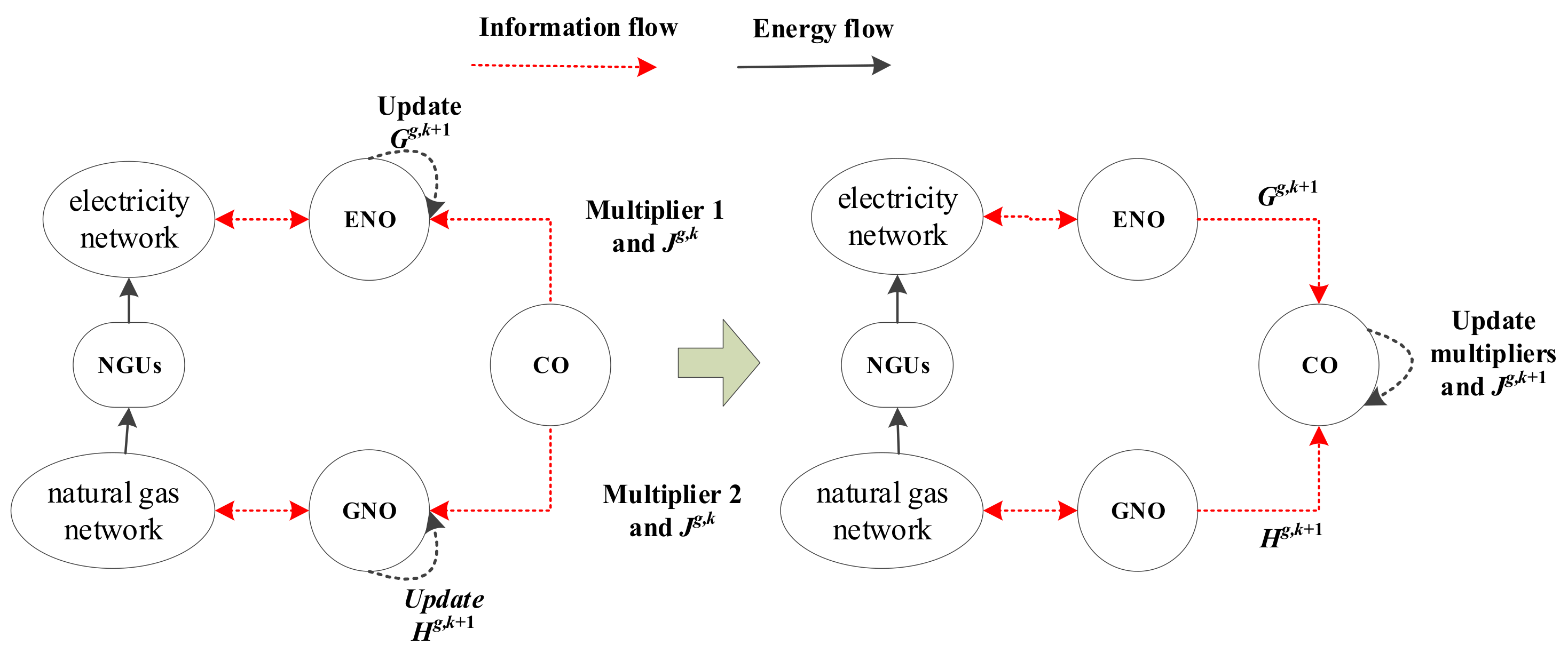
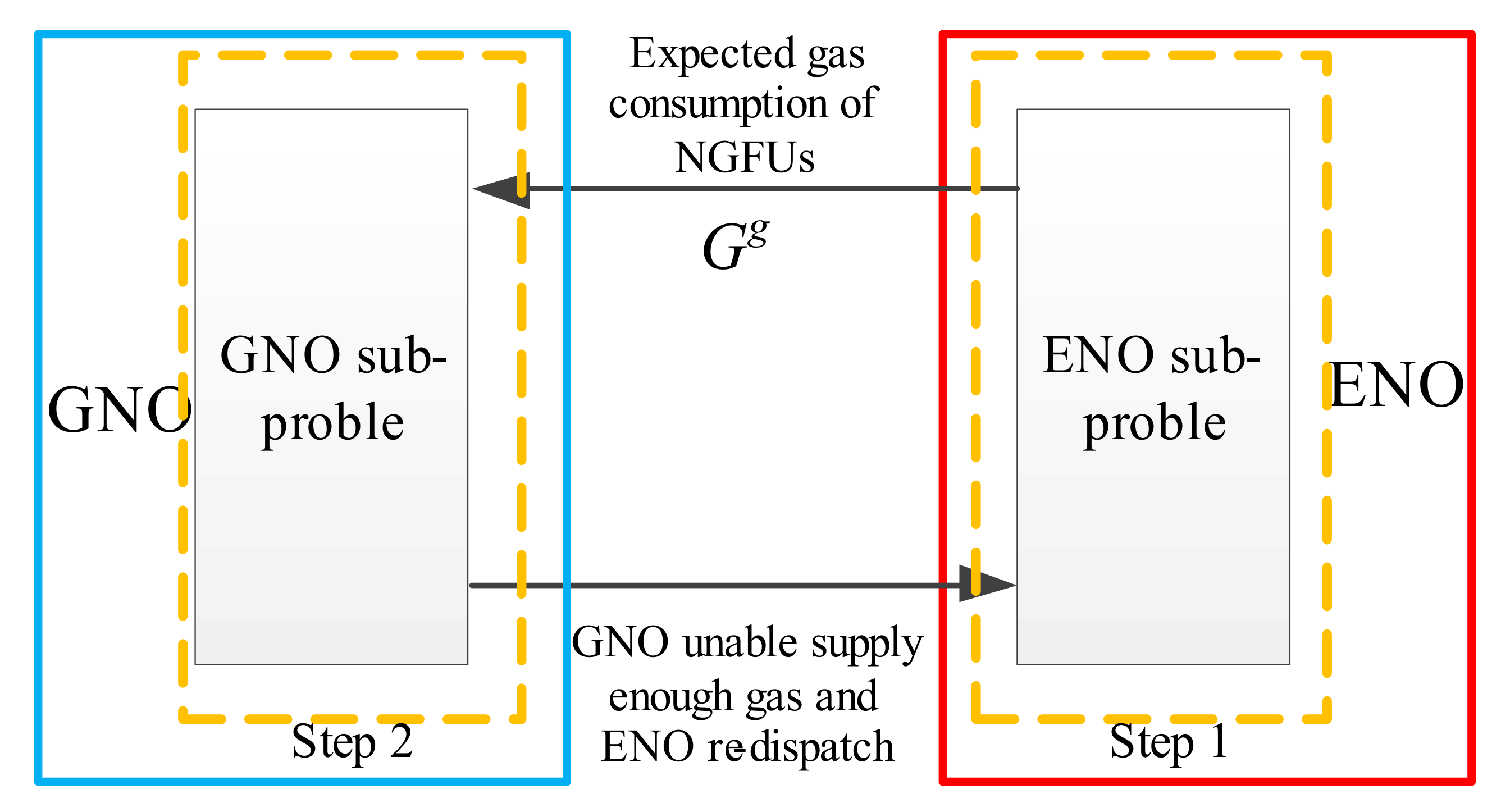
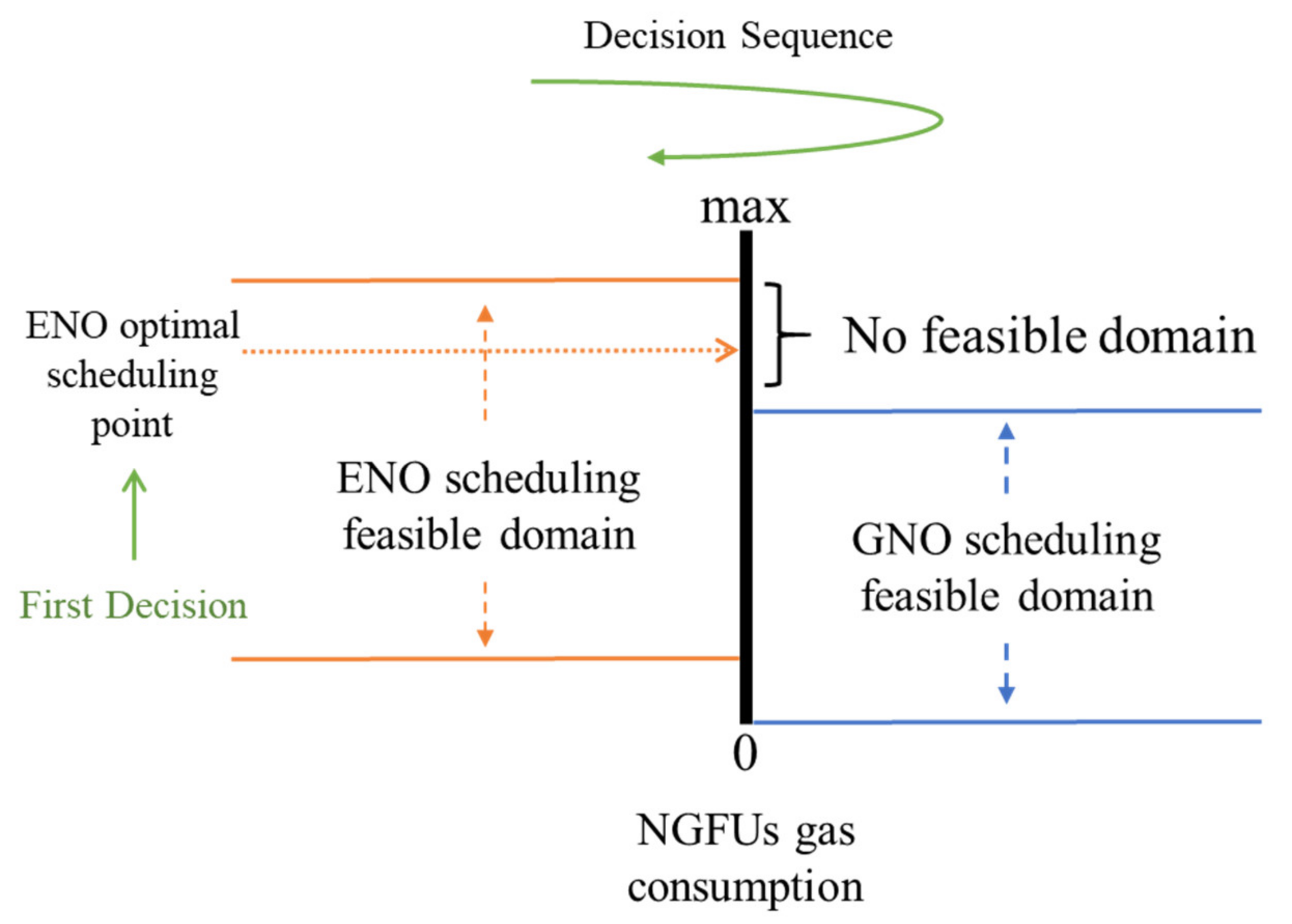
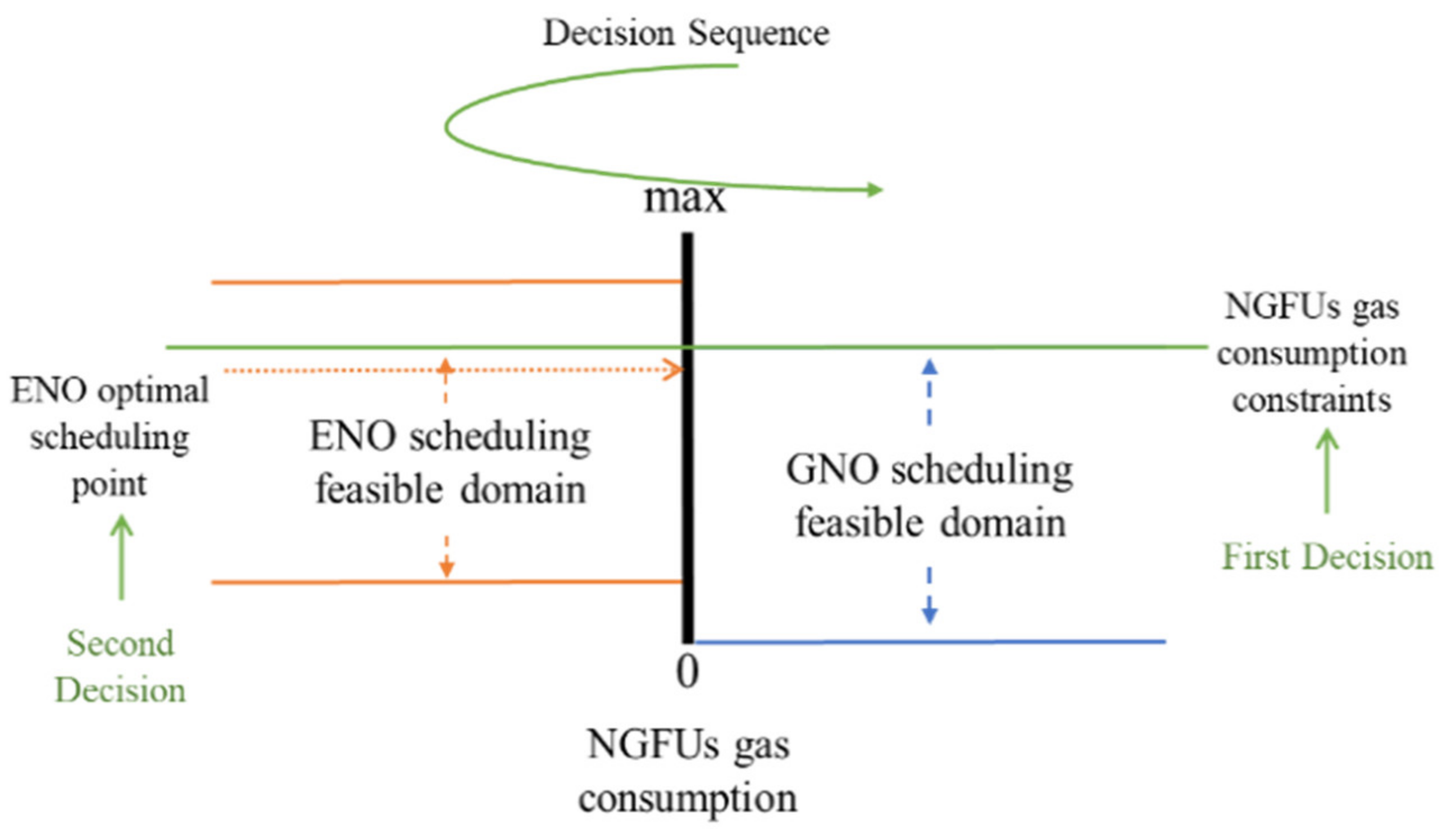
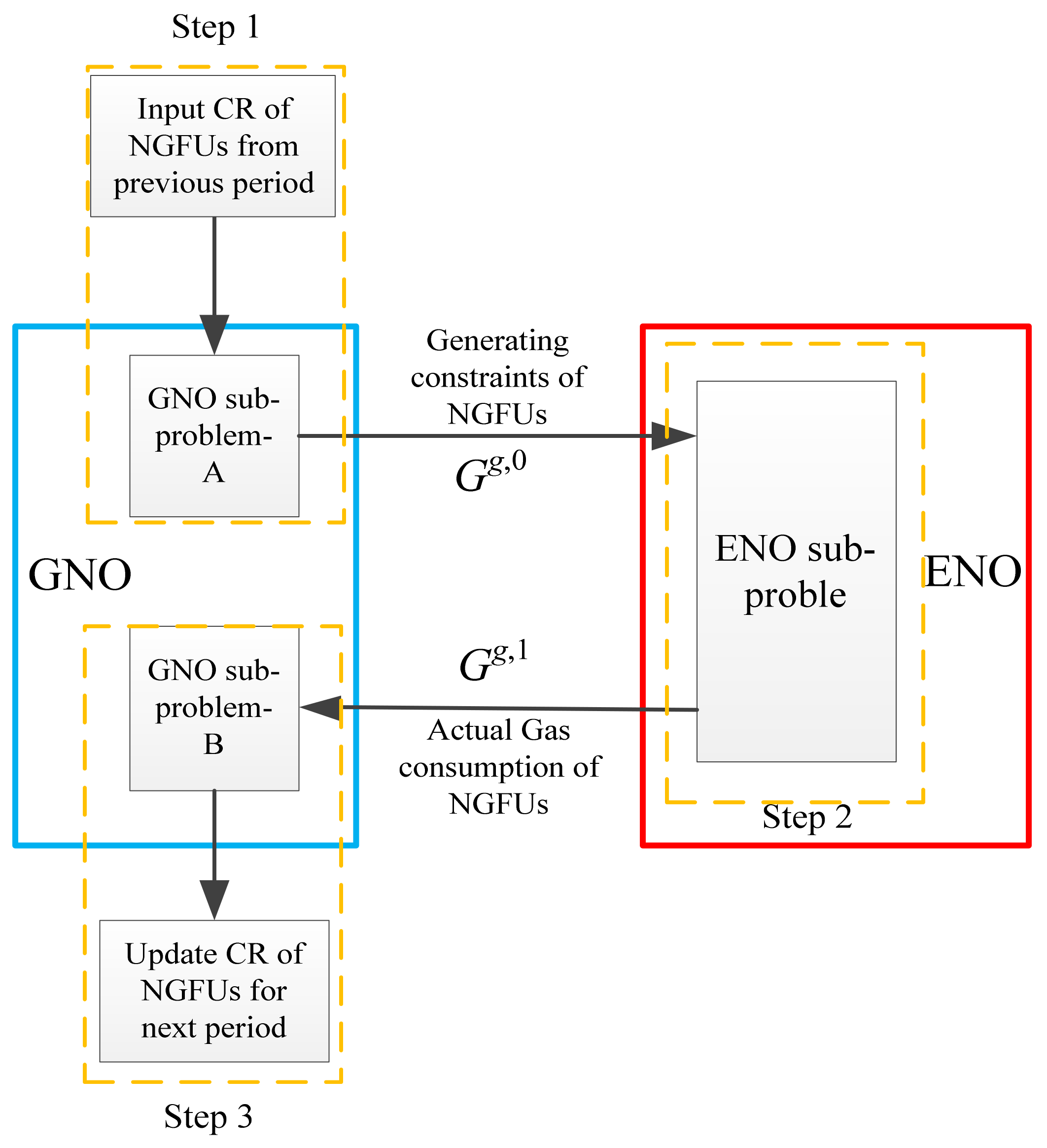

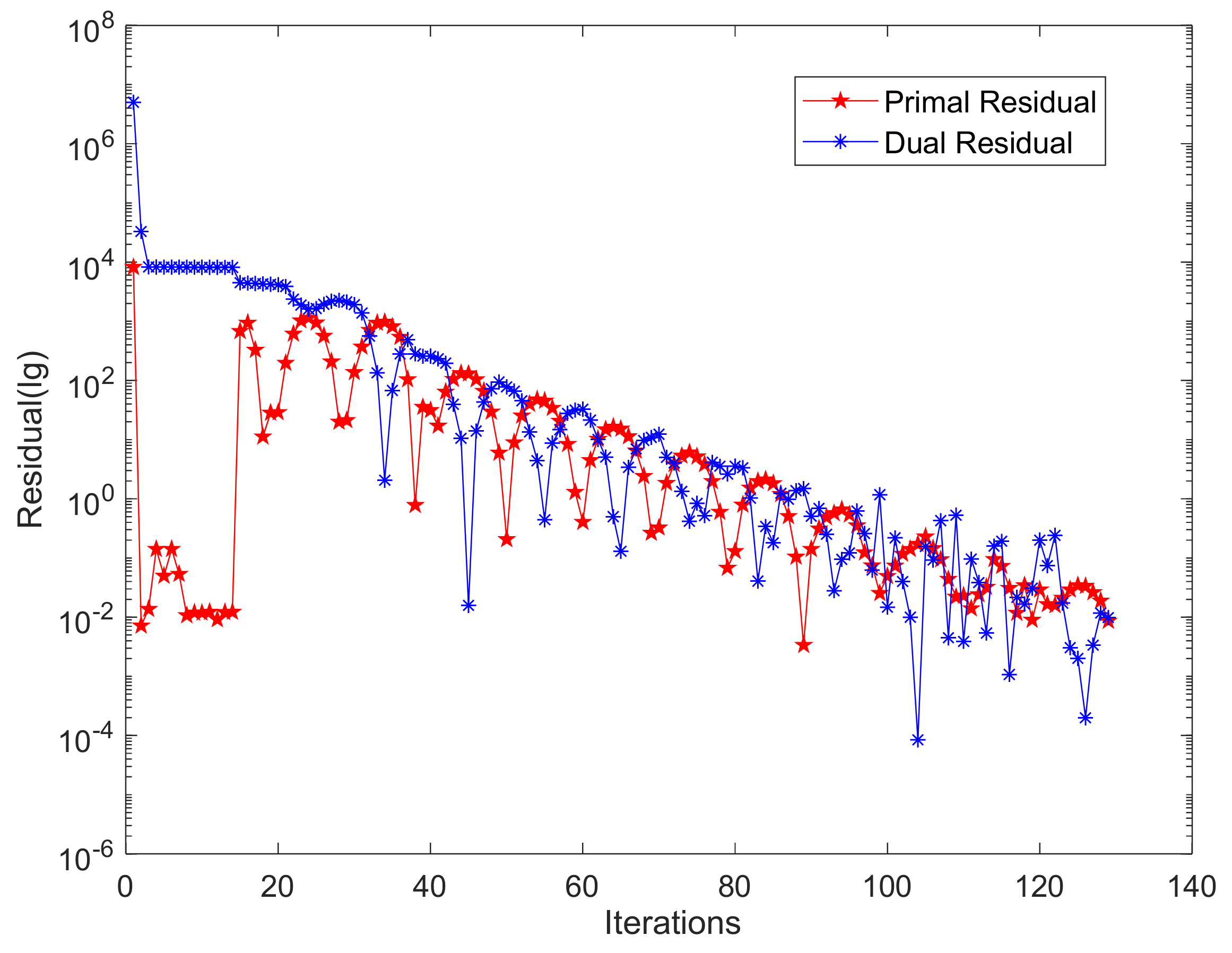
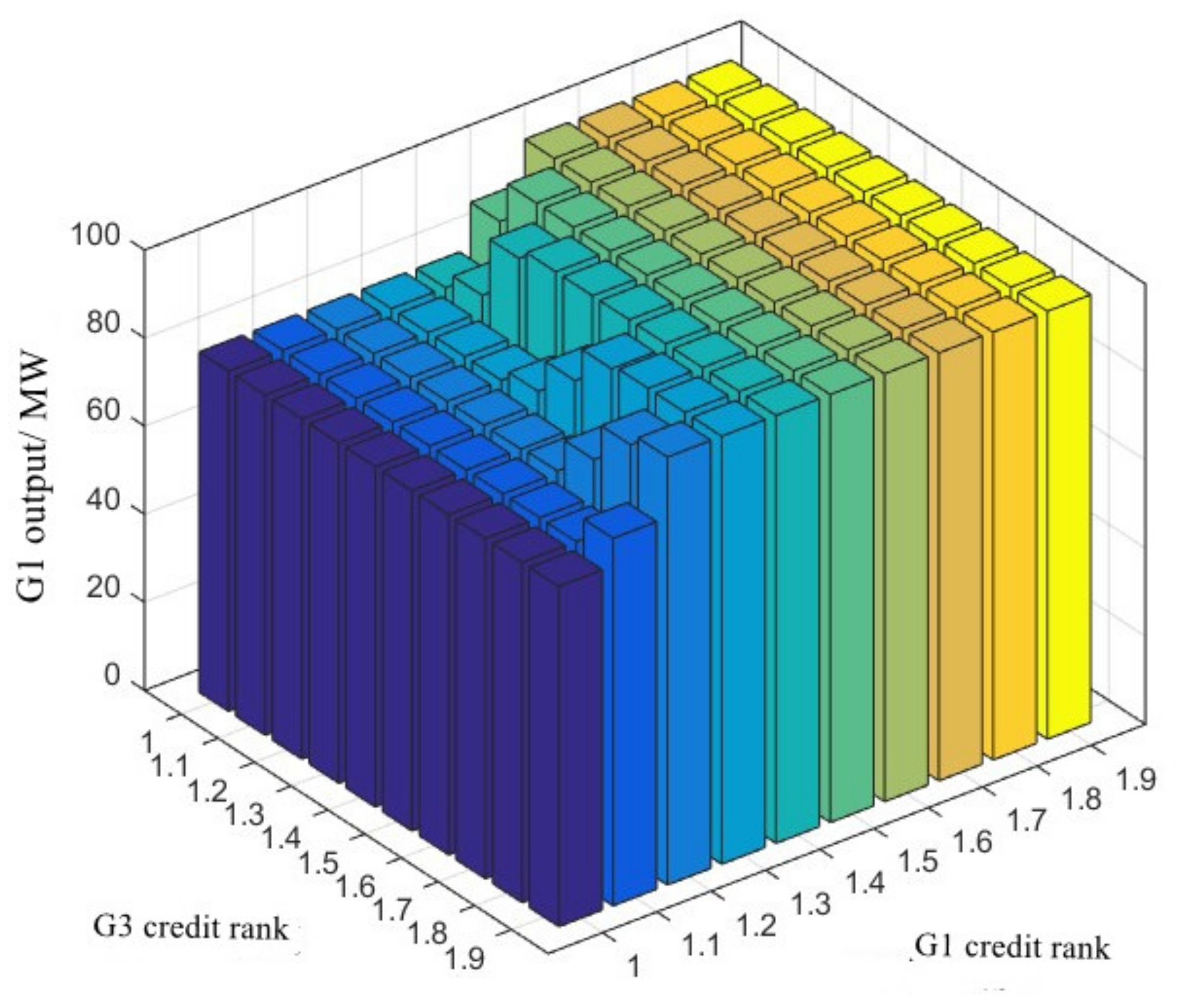

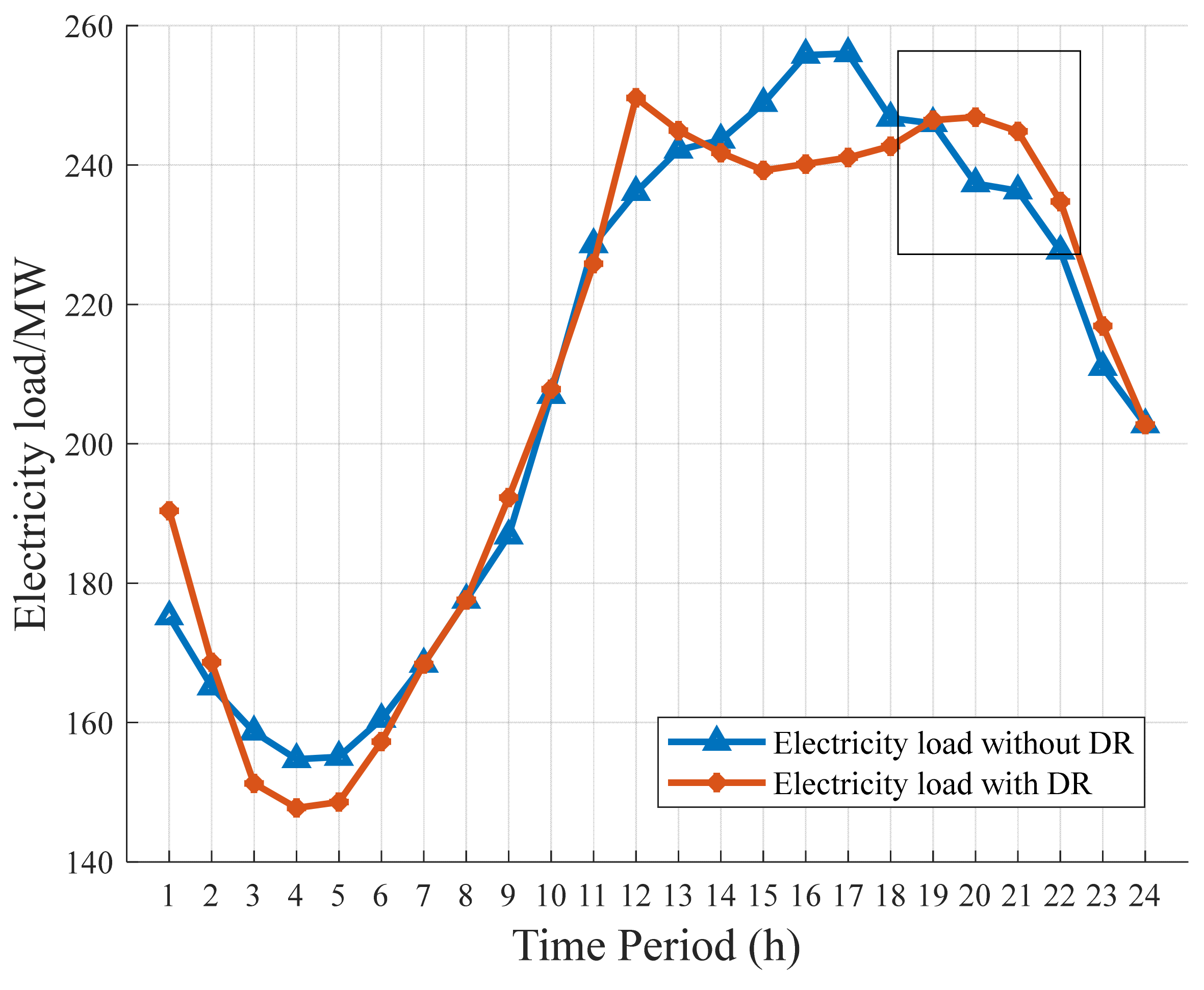
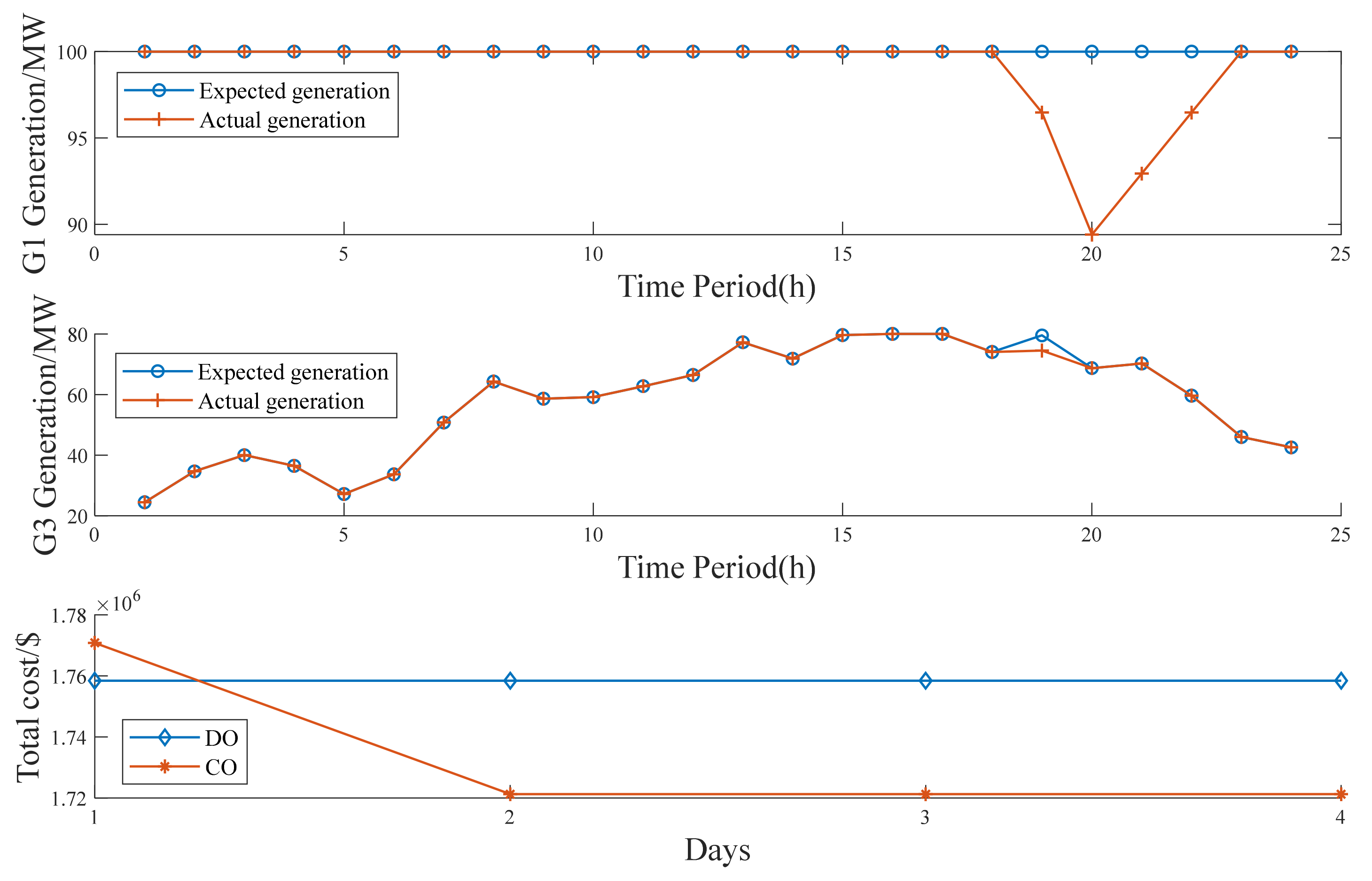
| Source | Connection Node | Minimum Capacity (kcf/h) | Maximum Capacity (kcf/h) | Cost ($/kcf) |
|---|---|---|---|---|
| S1 | 4 | 2000 | 5000 | 3.2 |
| S2 | 5 | 1500 | 6000 | 2.6 |
| Pipeline Number | Start Node | End Node | Pipeline Constant (kcf/Psig) |
|---|---|---|---|
| 1 | 2 | 1 | 50.6 |
| 2 | 4 | 2 | 50.1 |
| 3 | 5 | 2 | 37.5 |
| 4 | 5 | 3 | 43.5 |
| 5 | 6 | 5 | 45.3 |
| Methods | DO | ADMM | Proposed Framework (CO) |
|---|---|---|---|
| CPU time (s) | 1.51 | 241.39 | 2.29 |
| Gas shortage (kcf) | 280.38 | 0 | 0 |
| Load shedding (MW) | 17.76 | 0 | 0 |
| Power generation cost ($) | 22,358.3 | 22,969.2 | 22,969.5 |
| Load shedding cost ($) | 1176 | 0 | 0 |
| Total cost of electricity ($) | 23,534.3 | 22,969.5 | 22,969.5 |
| Gas network income ($) | 15,781.9 | 17,794.9 | 17,794.9 |
| Iteration | 1 | 2 | 3 | 4 | 5 | 6 | |
|---|---|---|---|---|---|---|---|
| Gap-S | PF point | 1385.308 | 2.707 | 0.652 | 0.366 | 0.048 | N/A |
| Zero point | 707557.820 | 471.389 | 365.477 | 205.691 | 0.300 | 0.038 | |
| Gap-Z | PF point | 143.076 | 139.152 | 0.730 | 0.552 | 0.090 | N/A |
| Zero point | 305592.919 | 70906.237 | 48.071 | 15.128 | 164.559 | 0.067 |
| Case 2 | Case 3 | |||
|---|---|---|---|---|
| DO | CO | DO | CO | |
| Gas shortage of NGFUs (kcf) | 428.3 | 0 | 728.8 | 0 |
| Load shedding (MW) | 29.7 | 0 | 46 | 0 |
| Decentralized Operation | Coordinated Operation | |||
|---|---|---|---|---|
| Without DR | With DR | Without DR | With DR | |
| Without pipelines congestion | 1708547.2 $ | 1687651.1 $ | 1708547.2 $ | 1687645.0 $ |
| Pipelines congestion | 1762052.3 $ | 1770473.1 $ | 1721257.2 $ | 1700798.7 $ |
Publisher’s Note: MDPI stays neutral with regard to jurisdictional claims in published maps and institutional affiliations. |
© 2021 by the authors. Licensee MDPI, Basel, Switzerland. This article is an open access article distributed under the terms and conditions of the Creative Commons Attribution (CC BY) license (https://creativecommons.org/licenses/by/4.0/).
Share and Cite
Lai, C.S.; Yan, M.; Li, X.; Lai, L.L.; Xu, Y. Coordinated Operation of Electricity and Natural Gas Networks with Consideration of Congestion and Demand Response. Appl. Sci. 2021, 11, 4987. https://doi.org/10.3390/app11114987
Lai CS, Yan M, Li X, Lai LL, Xu Y. Coordinated Operation of Electricity and Natural Gas Networks with Consideration of Congestion and Demand Response. Applied Sciences. 2021; 11(11):4987. https://doi.org/10.3390/app11114987
Chicago/Turabian StyleLai, Chun Sing, Mengxuan Yan, Xuecong Li, Loi Lei Lai, and Yang Xu. 2021. "Coordinated Operation of Electricity and Natural Gas Networks with Consideration of Congestion and Demand Response" Applied Sciences 11, no. 11: 4987. https://doi.org/10.3390/app11114987
APA StyleLai, C. S., Yan, M., Li, X., Lai, L. L., & Xu, Y. (2021). Coordinated Operation of Electricity and Natural Gas Networks with Consideration of Congestion and Demand Response. Applied Sciences, 11(11), 4987. https://doi.org/10.3390/app11114987








